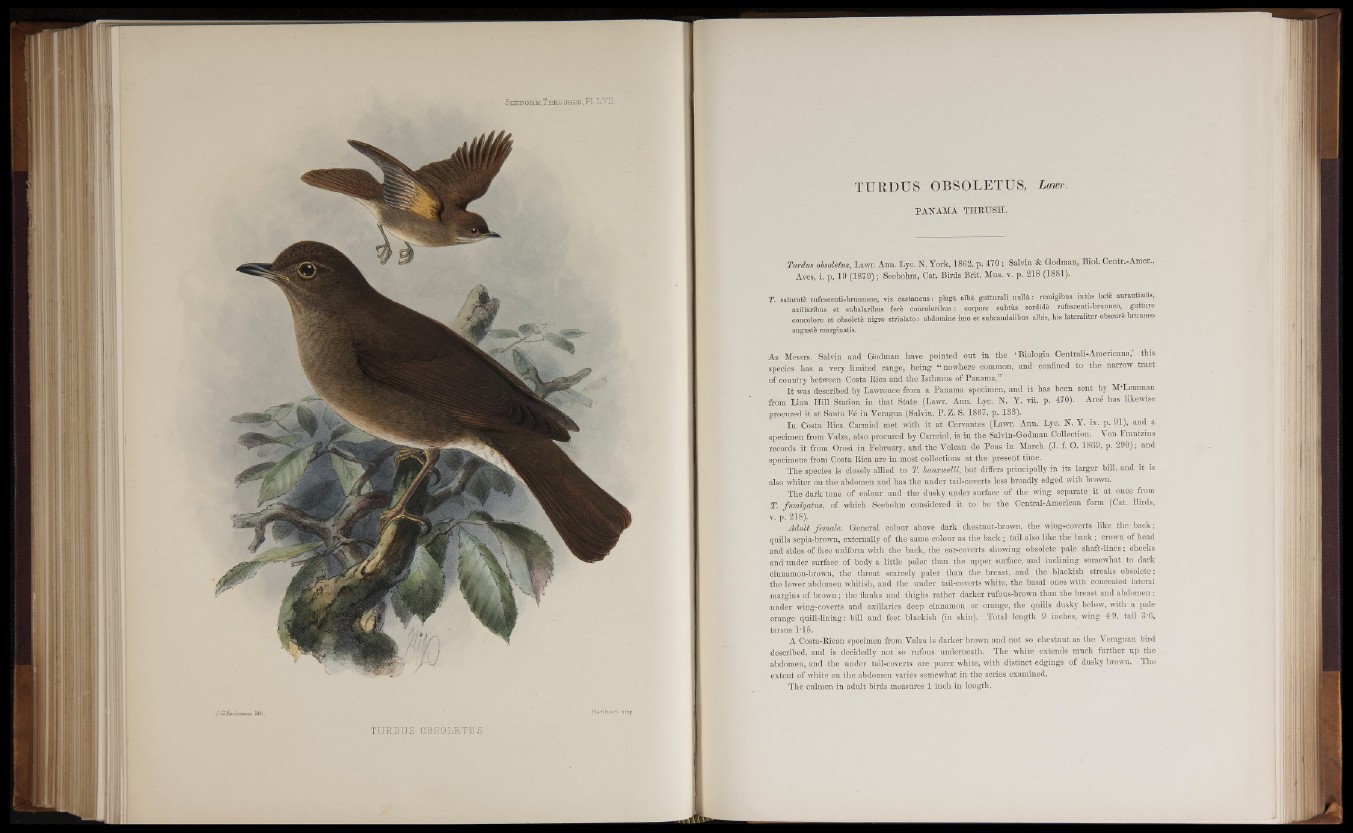
TURDUS OBSOLETUS, Lawr
PANAMA. THRUSH.
Turdm obsoletus, Lawr. Ann. Lyc. N. York, 1862, p. 470; Satan & Godman, Biol. Centr.-Amer.,
Aves, i. p. 19 (1879); Seebfthm, Oat. Birds Brit. Mus. v. p. 218 (1881).
T. saturate rufeseenti-brunneus, vix castaneus: plagit alM gutturali n u ll» : remigibus in t is la t e aurantiacis,
axillaxibus et subalaribus fere concoloribus : corpore subtus sordide rufescenti-brunneo, gatture
eoncolore et obsolete nigro striolato : abdomine imo et subcaudalibus albis, his lateraliter obscure brunneo
anguste marginatis.
As Messrs. Natan and Godman have pointed out in the ‘ Biologia Oentrali-Americana, this
species has a very limited range, heing “ nowhere common, and confined to the narrow tract
of country between Costa Rica and the Isthmus of Panama.”
It was described by Lawrence from a Panama specimen, and it has been sent by M‘Leannan
from Lion Hill Station in that State (Lawr. Ann. Lyc. N. Y. vii. p. 470). Arce has likewise
procured it at Santa F4 in Yeragua (Salvin, P. Z. S. 1867, p. 138).
In Costa Rica Carmiol met with it at Cervantes (Lawr. Ann. Lyc. N. Y. is. p. 91), and a
specimen from Valza, also procured by Carmiol, is in the Salvin-Godman Collection. Von Frantzius
records it from Orosi in February, and the Volcan de Poas in March (J. f. O. 1869, p. 290); and
specimens from Costa Rica are in most collections at the present time.
The species is closely allied to T. hauxwelli, but differs principally in its larger bill, and it is
also whiter on the abdomen and has the under tail-coverts less broadly edged with brown.
The dark tone of colour and the dusky under surface of the wing separate it at once from
T. fumiqatus, of which Seebohm considered it to be the Central-American form (Cat. Birds,
v. p. 218).
Adult female. General colour above dark chestnut-brown, the wing-coverts like the back;
quills sepia-brown, externally of the same colour as the back; tail also like the back; crown of head
and sides of face uniform with the back, the ear-coverts showing obsolete pale shaft-lincs; cheeks
and under surface of body a little paler than the upper surface, and inclining somewhat to dark
cinnamon-brown, the throat scarcely paler than the breast, and the blackish streaks obsolete;
the lower abdomen whitish, and the under tail-coverts white, the basal ones with concealed lateral
margins of brown; the flanks and thighs rather darker rufous-brown than the breast and abdomen ;
.under wing-coverts and axillaries deep cinnamon or orange, the quills dusky below, with a pale
orange quill-lining: bill and feet, blackish (in skin). Total length 9 inches, wing 4'9, tail 3'6,
tarsus IT 5.
A Costa-Rican specimen from Valza is darker brown and not so chestnut as the Veraguan bird
described, and is decidedly not so rufous underneath. The white extends much further up the
abdomen, and the under tail-coverts are purer white, with distinct edgings of dusky brown. The
extent of white on the abdomen varies somewhat in the series examined.
The culmen in adult birds measures 1 inch in length.